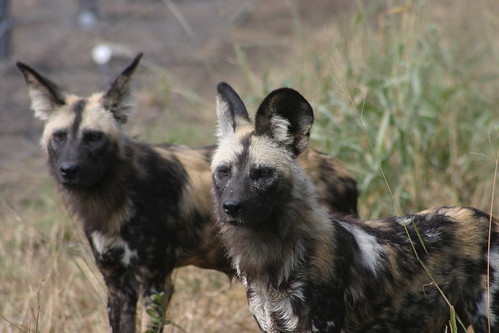Canid Fieldwork Results in Two Significant Papers for Smithsonian Conservation Biology Institute Scientists

Two research papers published this spring by Smithsonian Conservation Biology Institute scientists and partners will form the building blocks for conservation biologists to take action in saving canid species on two continents. The work on African wild dogs and dholes, or Asiatic wild dogs, brings together SCBI's ecologists, geneticists and reproductive experts.
African Wild Dogs
The first paper, published in PLoSONE, matched genetic data with behavioral observations to determine that African wild dogs employ a mechanism to avoid inbreeding. While inbreeding can genetically weaken a species and affect its long-term viability, the researchers predict that the combination of this mechanism and the isolation of wild dog populations can rapidly lead to the extinction of small and reintroduced populations of this endangered species.
"The potential effects of inbreeding is a really important factor to consider in the management and conservation of African wild dogs," said Penny Becker, SCBI research associate and lead author of the paper. "It means that conservation efforts should really focus on translocating animals between segregated populations to mimic natural immigration that isn't possible any longer because of habitat fragmentation."
The 11-year study included 114 wild dogs from Hluhluwu-iMfolozi Park in South Africa, where reintroduction efforts have been ongoing since the 1980s. SCBI scientists helped conduct the fieldwork and provided training, while the noninvasively collected genetic material was analyzed at SCBI's genetics lab. The next step in the research will be to determine what exact mechanism the animals use to avoid inbreeding and recognize their kin.
African wild dogs are considered endangered by the International Union for Conservation of Nature as the result of human-animal conflict and infectious disease. There are 4,000 to 5,500 animals left in their native habitat, which ranges from eastern to southern Africa, with the largest strongholds in Tanzania and Botswana.
Dholes
The second study, published in Mammalia, found that only 7 percent of the total land area in Thailand is likely suitable for dholes. The four-year study is based on camera trap photos taken in 15 protected areas in Thailand. The researchers also determined the factors most likely to influence where dholes live, including prey availability, vegetation and landscape, competition with other carnivores and human presence.
"When we look at why a species is declining and how to conserve it, we have to understand that the individual species is not the only factor," said Kate Jenks, SCBI research associate and lead author of the study. "We can't solve the problem until we also understand the natural environments in which the endangered species live."
The study's authors used distribution modeling tools to develop the first-ever distribution map for dholes. They found that: 1) vegetation type does not seem to constrain dholes, 2) dholes are most likely to live at less than 500 meters elevation and 3) the animals live most frequently in the range of sambar, a species that is among dholes' primary sources of prey. From the models, the scientists identified four protected areas in Thailand where dholes range across the entire space. The next step in the research will be to determine the precise size and stability of dhole populations and to determine whether dholes are using areas outside of protected areas, according to Jenks.
Dholes are an elusive species that range in parts of India, Bhutan, Burma, Thailand, Vietnam, Cambodia, Malaysia and Indonesia. The IUCN lists them as endangered, with fewer than 2,500 left in the wild. Their biggest threat is habitat loss and depletion.
In addition to Becker, the authors of the African wild dog paper are Micaela Szykman Gunther, associate professor at Humboldt State University and SCBI research associate; David Wildt, head of SCBI's Center for Species Survival; Jesús Maldonado, SCBI research geneticist; Philip Miller of the Conservation Breeding Specialist Group; and Michael Somers of the Centre for Wildlife Management at the University of Pretoria.
In addition to Jenks, the authors of the dhole paper are Peter Leimgruber, SCBI research biologist; Nucharin Songsasen, SCBI research biologist; Shumpei Kitamura at the Museum of Nature and Human Activities; Antony Lynam at the Wildlife Conservation Society; Dusit Ngoprasert, Wanlop Chutipong, Naruemon Tantipisanuh and George Gale at the King Mongkut's University of Technology; Robert Steinmetz at the World Wildlife Fund for Nature-Thailand; Lon Grassman Jr. at Texas A&M University-Kingsville; Passanan Cutter at the University of Minnesota; Ronglarp Sukmasuang and Naris Bhumpakphan at Kasetsart University; David Reed at the University of Louisville.
The Smithsonian Conservation Biology Institute plays a key role in the Smithsonian's global efforts to understand and conserve species and train future generations of conservationists. Headquartered in Front Royal, Va., SCBI facilitates and promotes research programs based at Front Royal, the National Zoo in Washington, D.C., and at field research stations and training sites worldwide.
# # #

